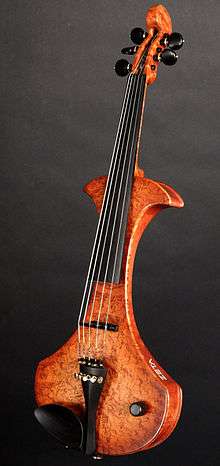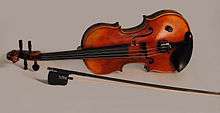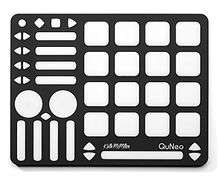Keith McMillen
Keith McMillen (Born July 10, 1957, Bermuda) is an audio and music technology engineer and entrepreneur, known for developing electronic music instruments, including the first modern violin to control synthesizers, first programmable audio mixer, the first blue-tooth violin bow, and several MIDI controllers as well as innovations to improve audio quality for internet telephony.

Biography
McMillen was raised on Chicago's South Side. When he was 10 years old, he built a guitar amplifier because he couldn’t afford to buy one, and he wanted to make his guitar louder. Building and repairing musical instruments paid for his attendance at the University of Illinois at Urbana-Champaign, where he received a degree in Acoustics in 1977. He moved to California in 1979.
Zeta Music and Octiv

McMillen founded the music company Zeta Music in 1979 to create a modern version of electric and electronic string instruments. He developed a prototype electric violin for avant-garde musician Laurie Anderson. Zeta Violins are still in production 37 years later. With the University of California Berkeley's Center for New Music and Audio Technologies (CNMAT), McMillen created Zeta Instrument Processor Interface(ZIPI), a high-speed music network, which was included in the Winter 1994 Computer Music Journal and which laid the groundwork for Open Sound Control (OSC). The company was sold to Gibson Guitars in 1992.
McMillen founded Octiv in 2000, with funding from 3i and Intel Capital. Octiv was an audio signal processing company that addressed the problem of inconsistent volume levels and audio quality across delivery platforms. It produced the Volume Logic multiband processing plug-in for iTunes. The company was sold to Plantronics (NYSE:PLT) in 2005, which renamed it as the Volume Logic division.[1]
Keith McMillen Instruments
In 2005, Keith McMillen founded Keith McMillen Instruments (KMI), a hardware and software company that designs music and stage equipment that interfaces with computers. He founded the company after touring as a musician with large, cumbersome gear and recognized the need for equipment compact enough to easily carry on an airplane. The resulting devices are "polyphonic multidimensional controllers," and in addition to USB and MIDI capability, some can use the proposed MIDI extension MPE, which enables polyphonic aftertouch and sophisticated responsiveness.
KMI products include the K-Bow, a bluetooth-enabled sensor bow for stringed instruments; the K-Mix USB audio interface and programmable standalone mixer[2]; the K-Board keyboard that uses "smart fabric" sensors under the keys detect velocity, pressure, and tilt[3][4]; the QuNexus, a compact MIDI/CV smart sensor keyboard controller, supported by the second successful Kickstarter crowdfunding campaign for KMI, and was the first time a startup company had a successful repeat performance using a Kickstarter campaign.[5]; the QuNeo controller, a 3D multi-touch MIDI pad controller for electronic music producers, DJs and VJs (and another Kickstarter-funded project); the SoftStep 2 programmable MIDI foot controller[6] and 12 Step MIDI foot controller and pedal keyboard.[7]




KMI Labs
KMI Labs is the research and development (R&D) division of Keith McMillen Instruments. McMillen outlined future instruments KMI Labs at a Future of Music presentation at the Gray Area Foundation for the Arts in October 2015, including the BopPad expressive MIDI drum pad controller[8][9].
In October 2014, McMillen launched BeBop Sensors to capitalize on manufacturing interest in the smart fabric sensors utilized in KMI devices. BeBop provides "sensor solutions" for OEMs ranging from complete wireless solutions to custom apps. Their proprietary monolithic fabric sensor technology integrates the sensors, traces, and electronics into a single piece of fabric that is ultra-thin, washable, bendable, and has no protruding wires. DuPont Microcircuit Materials prints the conductive inks on the fabric. The sensors can measure size, motion, angle, location, weight, bend, rotation, force, shape, and pressure.[10]
BeBop sensors can create 3D data maps, for instance being built into a 1mm thick shoe insole to measure gait, contact, and fit. The 3D mapping allows the sensors to measure impact under a helmet, or other protective gear. It can be a grip sensor for improving an ergonomic grip. BeBop Sensors developed technology for a smart tire that measures tread wear and provides information about suspension. The sensors are being incorporated into a smart steering wheel, and are being developed for use in a shoe insole and other products.[11]
BEAM Foundation
McMillen founded the non-profit BEAM Foundation in 2005 with a mission to create conditions that spark a new music movement, dubbed "the NuRoque" (from Neo-Baroque).[12]
Patents
McMillen is the inventor on the following patents:
- US Patent No. 9,183,823: "Pickup and sustainer for stringed instruments"[13]
- US Patent No. 9,076,419: Multi-touch pad controller [14]
- US Patent No. 9,075,404: Foot-operated controller[15]
- US Patent No. D706,230: Musical controller[16]
- US Patent No. 8,680,390: Foot-operated controller[17]
- US Patent No. 8,581,106: Computer interface for polyphonic stringed instruments [18]
- US Patent No. D680,502: Musical controller[19]
- US Patent No. D660,808: Foot-operated controller [20]
- US Patent No. 8,084,678: Sensor bow for stringed instruments [21]
- US Patent No. 7,433,462: Techniques for improving telephone audio quality [22]
- US Patent No. D525,231: Personal conferencing node [23]
- US Patent No. 5,757,941 Audio signal patching mixer and method [24]
- US Patent No.[25] 5,483,535 Communications network interface, and adapter and method therefor
- US Patent No. 4,922,754 Acoustic emission transducer and mounting adapter for monitoring metalcutting tools[26]
External links
References
- "Plantronics buys Octiv". Silicon Valley Business Journal. Retrieved 5 April 2005.
- Collecchia, Gina. "Keith McMillen Instruments' K-Mix: a closer look". synthtopia.com. Retrieved 18 January 2016.
- Ridden, Paul. ""Unbreakable" K-Board is ready for your next music creation adventure". Gizmag.com. Gizmag. Retrieved 17 October 2014.
- Rogerson, Ben. "Keith McMillen introduces $99 K-Board controller". musicradar.com. Musicradar. Retrieved 7 November 2014.
- Burlacu, Alexandra. "KMI Returns to Kickstarter with QuNexus Smart Sensor Keyboard Controller". Mobile & Apps. Retrieved 22 November 2012.
- Gore, Joe. "Quick Hit: Keith McMillen Instruments Soft Step2 MIDI Foot Controller". PremierGuitar.com. Retrieved 18 June 2014.
- Mallery, Sam. "Keith McMillen Instruments 12 Step Foot Controller". B&H Photo Video Pro Audio.
- http://www.gambitmag.com/2016/09/boppad-smart-drum-pad-looks-advanced-electronic-drum-pad-ever/
- https://ask.audio/articles/boppad-worlds-most-responsive-accurate-drum-pad-from-kmi-bebop-sensors
- Fingas, Jon. "BeBop's smart fabric puts sensors in everything you wear". engadget.com. Retrieved 27 October 2014.
- Savastano, David. "Smart Fabric Sensor Solutions are BeBop Sensors' Forte". PrintedElectronicsNow.com.10 August 2015.
- Duron, Ysabel (March 4, 2007). "KRON-TV Weekend News".
- "US Patent No. 9,183,823". US Patent & Trademark Office, Patent Full Text and Image Database.
- "US Patent No. 9,076,419". US Patent & Trademark Office Patent Full Text and Image Database.
- "US Patent No. 9,075,404". US Patent & Trademark Office Patent Full Text and Image Database.
- "US Patent No. D706,230". US Patent & Trademark Office Patent Full Text and Image Database.
- "US Patent No. 8,680,390". US Patent & Trademark Office Patent Full Text and Image Database.
- "US. Patent No. 8,581,086". US Patent & Trademark Office Patent Full Text and Image Database.
- "US Patent No. D680,502". US Patent & Trademark Office Patent Full Text and Image Database.
- "US Patent No. D660,808". US Patent & Trademark Office Patent Full Text and Image Database.
- "US Patent No. 8,084,678". US Patent & Trademark Office Patent Full Text and Image Database.
- "US Patent No. 7,433,362". US Patent & Trademark Office Patent Full Text and Image Database.
- "US Patent No. D525,231". US Patent & Trademark Office Patent Full Text and Image Database.
- "US Patent No. 5,757,941". US Patent & Trademark Office Patent Full Text and Image Database.
- "US Patent No. 5,483,535". US Patent & Trademark Office, Patent Full Text and Image Database.
- "US Patent No. 4,922,754". US Patent & Trademark Office Patent Full Text and Image Database.